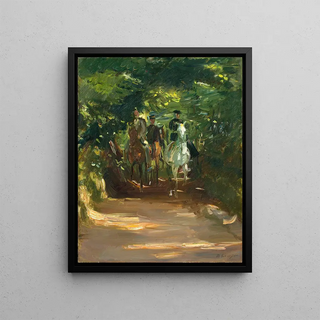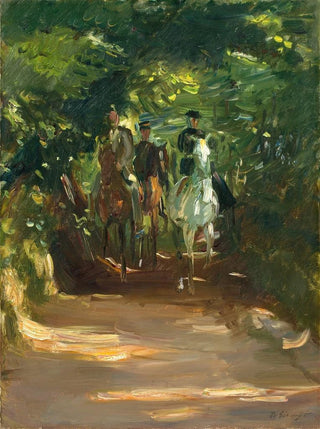Art print | Forest riding group - Max Slevogt


View from behind

Frame (optional)
Forest Riding Group - Max Slevogt – Captivating Introduction
In the rich and complex universe of art, certain works stand out for their ability to capture the essence of a fleeting moment and immortalize an atmosphere. "Forest Riding Group" by Max Slevogt is one of these creations that evoke both the beauty of nature and human dynamism. Through this canvas, Slevogt transports us to a lively scene where movement and light intertwine, revealing a delicate harmony between man and his environment. This artwork, emblematic of the early 20th century, invites viewers to immerse themselves in a world where the elegance of the riders blends with the majesty of the trees, creating a striking visual experience.
Style and uniqueness of the work
Slevogt's style is characterized by an impressionist approach that transcends simple representations of reality. In "Forest Riding Group," bold brushstrokes and vibrant colors come together to bring to life a scene full of movement. The horses, with their flowing manes, seem almost to animate before our eyes, while the riders, dressed in period costumes, add a touch of refinement to this composition. Light plays a crucial role, filtering through the foliage of the trees, creating shadows and reflections that enhance the depth of the piece. This blend of realism and abstraction allows Slevogt to explore human emotions while celebrating natural beauty, making this canvas a key piece in the artistic landscape of his time.
The artist and his influence
Max Slevogt, a key figure in German painting, made his mark through boldness and innovation. Born in 1868, he was influenced by the great masters of Impressionism while developing a personal style unique to him. Slevogt captured moments of life with rare sensitivity, highlighting the relationship between man and nature. His work is not limited to simple visual representation; it evokes feelings, memories, and dreams. Through exhibitions and collaborations with other artists, Slevogt contributed

Matte finish

View from behind

Frame (optional)
Forest Riding Group - Max Slevogt – Captivating Introduction
In the rich and complex universe of art, certain works stand out for their ability to capture the essence of a fleeting moment and immortalize an atmosphere. "Forest Riding Group" by Max Slevogt is one of these creations that evoke both the beauty of nature and human dynamism. Through this canvas, Slevogt transports us to a lively scene where movement and light intertwine, revealing a delicate harmony between man and his environment. This artwork, emblematic of the early 20th century, invites viewers to immerse themselves in a world where the elegance of the riders blends with the majesty of the trees, creating a striking visual experience.
Style and uniqueness of the work
Slevogt's style is characterized by an impressionist approach that transcends simple representations of reality. In "Forest Riding Group," bold brushstrokes and vibrant colors come together to bring to life a scene full of movement. The horses, with their flowing manes, seem almost to animate before our eyes, while the riders, dressed in period costumes, add a touch of refinement to this composition. Light plays a crucial role, filtering through the foliage of the trees, creating shadows and reflections that enhance the depth of the piece. This blend of realism and abstraction allows Slevogt to explore human emotions while celebrating natural beauty, making this canvas a key piece in the artistic landscape of his time.
The artist and his influence
Max Slevogt, a key figure in German painting, made his mark through boldness and innovation. Born in 1868, he was influenced by the great masters of Impressionism while developing a personal style unique to him. Slevogt captured moments of life with rare sensitivity, highlighting the relationship between man and nature. His work is not limited to simple visual representation; it evokes feelings, memories, and dreams. Through exhibitions and collaborations with other artists, Slevogt contributed






